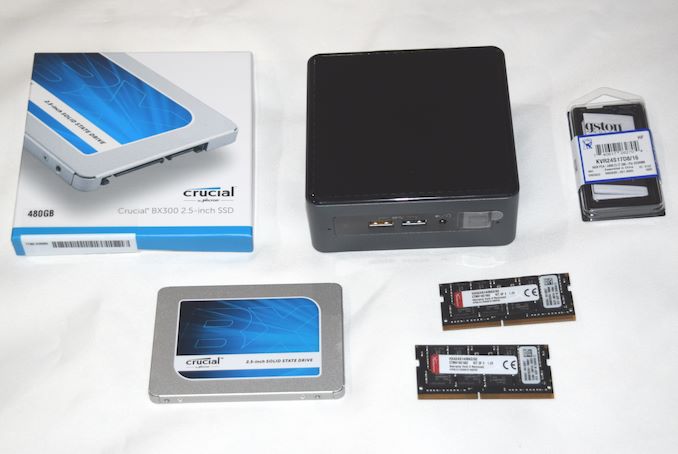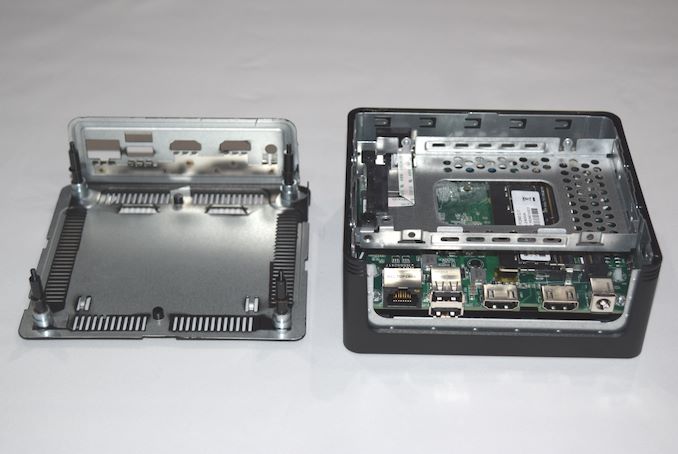Gemini Lake SFF PC Showdown: Intel's June Canyon (NUC7PJYH) and ECS's LIVA Z2 Reviewed
by Ganesh T S on December 20, 2018 8:00 AM ESTConcluding Remarks
Earlier I briefly touched upon the HTPC capabilities of the two Gemini Lake PCs. Of the two, the ECS LIVA Z2 is particularly attractive due to its passively cooled nature. Gemini Lake has one of the most power-efficient and full-featured video decoders in the market - It is capable of even handling VP9 Profile 2 in hardware. The only disappointing aspect from a HTPC viewpoint is that HDR is not supported. Consumers looking for a full-featured HTPC setup have to look beyond Gemini Lake for their needs. That said, if HDR is not a concern (as is likely in most TVs installed in a secondary location), Gemini Lake in general and the ECS LIVA Z2 in particular are good choices to consider.
Moving on to the power consumption aspect, we recorded the maximum sustained at-wall numbers while running the AIDA64 System Stability Test.

These numbers show that Gemini Lake, despite running at the same clocks as Apollo Lake, has managed to provide better performance per watt. The raw numbers are approximately the same when two systems with similar cooling situations are compared.
The Intel June Canyon NUC7PJYH Build Components
Coming to the business end of the review, Gemini Lake has shown itself to be a solid successor to Apollo Lake. Doubling the internal cache has led to significant performance increase in many real-life workloads. This is particularly evident when comparing the performance numbers of the NUC7PJYH (June Canyon) and the older NUC6CAYH (Arches Canyon). In addition to the performance bump, we also have better Wi-Fi capabilities. The product is not perfect, though - the installation of a 2.5" drive is not as easy as it is in some of the other UCFF PCs such as the ECS LIVA Z2. With the rise in popularity of M.2 SSDs, Intel could as well replace the 2.5" drive caddy with a M.2 SATA SSD-only slot on the motherboard, and reduce the system volume. The default fan curves could always use some tweaking, but, that is more of a subjective issue. These are very minor issues.
Accessing the Drive Caddy and the SODIMM Slots in the ECS LIVA Z2
On the other hand, the move from the ECS LIVA Z to the Z2 is a mixed bag. While the all-important fanless nature is still present, the retaining of aspects such as the measly 32GB of eMMC (with Windows 10 Home pre-installed) do not make for a good user experience. 32GB of eMMC may suffice for certain single-purpose industrial application systems, but, as a general-purpose PC, consumers will need to install an additional 2.5" SATA drive (similar to what we had to do for processing this review). Some consumers may appreciate the replacement of the mini-DP port in the LIVA Z with a full-sized HDMI one in the LIVA Z2. However, the sacrifice of a second LAN port for this is not a particularly good trade-off. That said, the performance increase enabled by Gemini Lake still makes the ECS LIVA Z2 a good choice over the ECS LIVA Z for most applications.












59 Comments
View All Comments
IntelUser2000 - Friday, December 21, 2018 - link
Well, the Gemini Lake SoC doesn't have gigabit LAN integrated. Since Gemini Lake integrates the chipset, it would have to be part of the chipset. Gigabit LAN might be too big for such a small die part.In their Core CPU platforms, the Gigabit LAN is in the separate chipset.
mode_13h - Friday, December 21, 2018 - link
Gigabit is like a million years old. There's no way it's too big.And the reason their desktop chips relegate it to South Bridge is because it doesn't *need* to be wasting space and I/O pins in the CPU. Especially since the board designer might decide to go with 10 Gig or whatever, instead.
coreai - Thursday, December 20, 2018 - link
J5005 on intel website shows max memory of 8GB yet you have installed 2x16GB... what’s the catch ?Death666Angel - Thursday, December 20, 2018 - link
You'd have to ask Intel. I have an Atom D2550 NAS that officially only supports 4GB. But I have 8GB installed without issues as have many others (Thecus N5550) My guess is that Intel doesn't want to impede on their lower end Core products with these Atom derived ones.ganeshts - Thursday, December 20, 2018 - link
That is funny, because I specifically installed 32GB just to show them that the spec was wrong :)Gemini Lake NUC has no issues supporting up to 32GB of RAM.
nandnandnand - Thursday, December 20, 2018 - link
So when is AMD going to get itself into one of these?HStewart - Thursday, December 20, 2018 - link
Never: Especially from Intel - but Intel has one with GPU integrated - but never with CPU.Does AMD have a super low power low cost chip like the Atom series. (Pentium)
RSAUser - Friday, December 21, 2018 - link
AMD has Athlone and I expect they will release truly low power with 7nm.mode_13h - Friday, December 21, 2018 - link
Oops, wrong again.https://www.anandtech.com/show/13053/sapphire-unve...
Real Ryzen cores should run circles around Goldmont+, and even a 3 CU Vega should stand up well to Intel's 18 EU HD Graphics (192 shaders vs. 144). Configurable TDP down to 12 W is comparable to the J5005's 10 W.
drzzz - Thursday, December 20, 2018 - link
The configuration comparison table on the first page is broken. It only shows the J5005 config for all possible choices in the right column. The J5005 is configured with what Intel says is an unsupported dimm size which begs the question how is this working? Actually the Pentium N5000 is also limited according to Intel to 8GB dimm modules. What is going on and why should I accept these results as valid if the configurations are not officially supported by Intel? No guarantee the unit I receive would be able to use 16GB modules and no guarantee it will perform like these test units. Disappointed by this article and the testing methodology used.